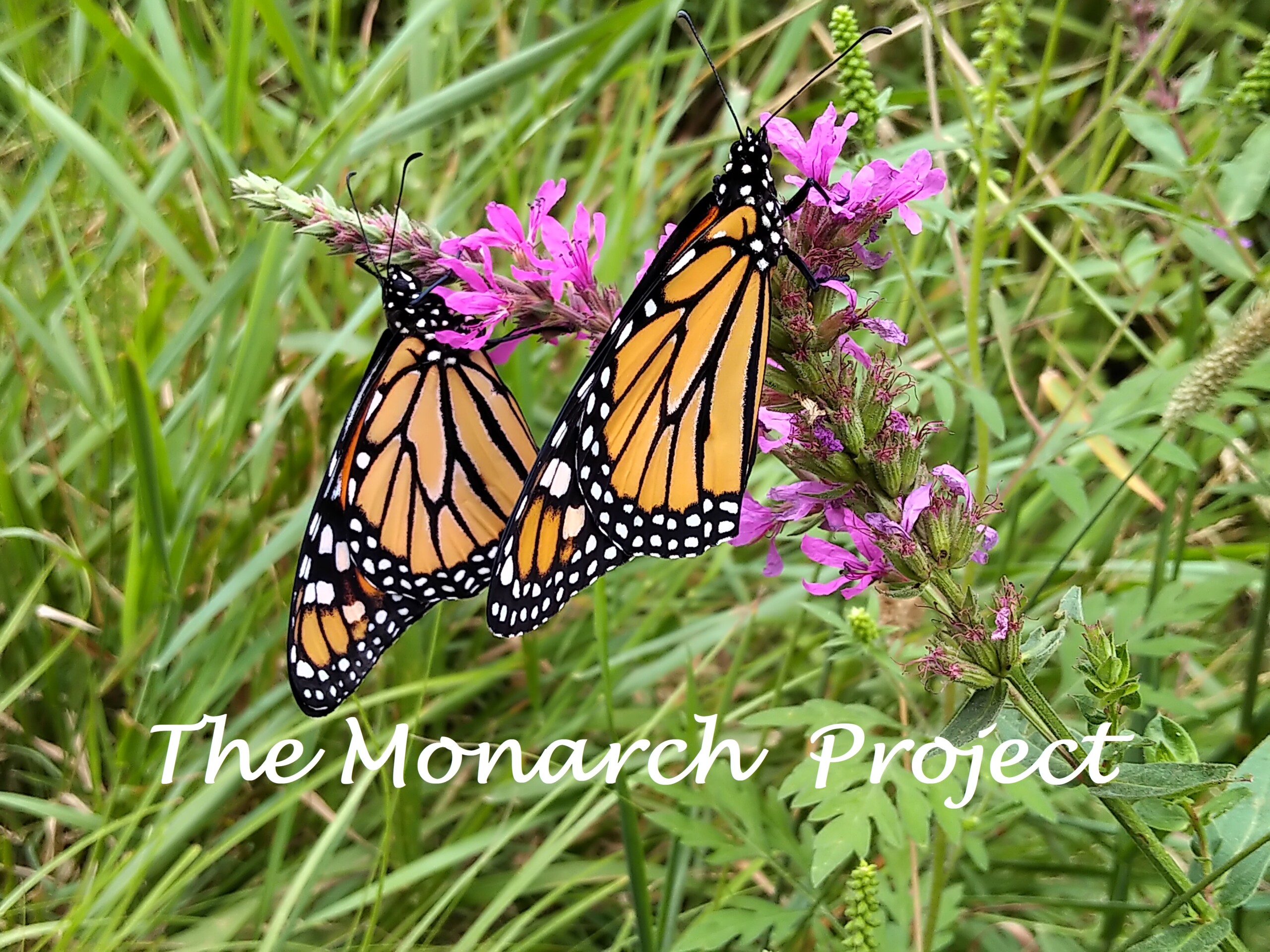
“Time to spread my wings and fly!” silently whispers the Monarch butterfly on Tuesday, August 24, 2021. This story about the Monarch caterpillar and butterfly along with its chrysalis form. Come with me on this journey to explore the different life stages of the Monarch and learn the twists and turns an adventure can bring.
The Monarch Project shares stories, pictures, and videos with different shots of the stages from the Monarch from caterpillar to a chrysalis then to a breathtaking butterfly where it spreads its wings into the blue sky for the first time.
This was my first time I located Monarch caterpillars on milkweed plants where it gorges until it is ready to morph into a beautiful green chrysalis.
Join me in this journey where witnessing the life stages of the Monarch captures our nature on our planet.
Metamorphosis
Four stages: Egg(s), Larva(e)/Caterpillar(s), Pupa(s)/Chrysalis (chrysalides), Adult(s)/Butterfly (butterflies)
Action: Lays, Hatches, Pupates, Emerges
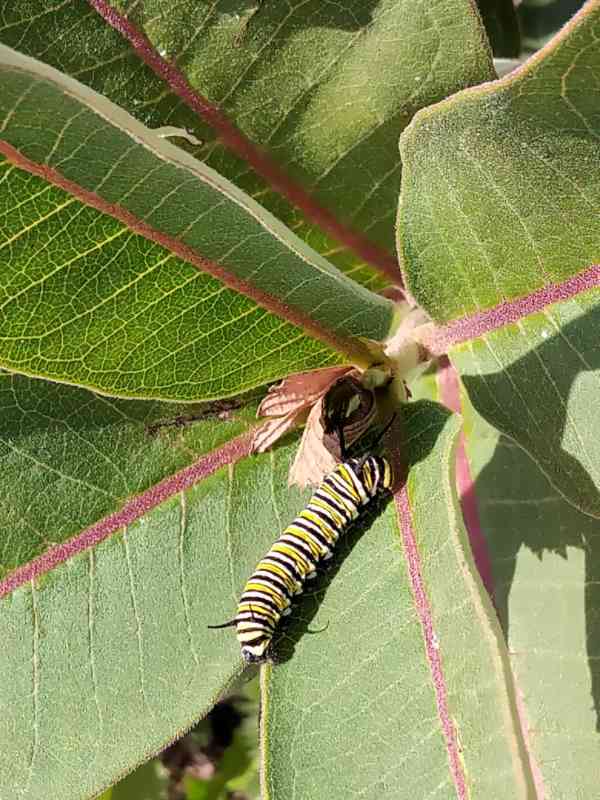
The Garden Project
Like any good story, there is a beginning. One Friday, August day while walking the grassy path to the one-acre garden with my new friend Nellie, I learned about how I can create a home for the Monarch caterpillar. Where is this garden? The location of this garden is just north of Orangeville (Ontario, Canada) and someone decided that milkweed was a good thing to plant on this hobby farm. Lucky with the weather, we took our time walking there. One of us looking on every milkweed for a Monarch caterpillar and the other looking for plants to identify and perhaps munch on while helping the other look for these crawling beauties. This year more than ever, foraging has been calling my name. Nellie has had many experiences bringing home Monarch caterpillars. She loved to watch them with her daughter become butterflies before her very eyes.
AMAZING FACT: A Monarch butterfly departs Mexico for Canada only to have her granddaughter (perhaps even a great granddaughter) return to Mexico by the winter to repeat the annual cycle in the Spring flying to Texas to lay her first eggs after mating with a male butterfly. The granddaughter emerges in Ontario to become a super butterfly. The super butterfly flies directly to Mexico without mating and laying any eggs. Source: Documentary, The Flight of the Butterflies.
The Monarch Caterpillar Home
While the first two Monarch caterpillars didn’t come home with us, the next Friday and with proper homes in hand from China town, we brought home our Monarch caterpillars. Let the learning begin! The home is a very airy basket-like container. When the fresh milkweed leaves are put inside, it is a suitable cozy home for the Monarch caterpillars to eat and grow. I left my Monarch caterpillars’ home outside every day on a table (so the dog couldn’t reach it.) The sunlight dappled the home through the oak tree leaves. This gave me peace that it was breathing in the fresh air and getting some natural light.
AMAZING FACT: Monarch butterflies taste with their feet and feel with their antennae.
The Time Before
Another part of this journey, only not this year but next, will be to locate the Monarch caterpillar eggs on the bottom part of the milkweed leaves which are left by the Monarch butterflies who fly up from their special hibernating place in Mexico. If you get a chance, watch the documentary ‘Flight of the Butterflies’ that was played at the Ontario Science Centre. It was an IMAX film so breathtaking to watch in the giant domed theatre. Recently, I borrowed this movie from the Toronto Public Library (for free.)
AMAZING FACT: Every Monarch butterfly that comes before the next, comes from the original butterflies. Whenever you see a Monarch butterfly, ponder its ancestry. You are seeing the greats of the original Monarch butterflies. That story is, perhaps, somewhat of a mystery but we can still marvel at the thought.
The Monarch Caterpillar’s Food
The Monarch caterpillar is birthed on the milkweed plant – its chosen food until it is ready to morph into a chrysalis, a pupa. The milkweed plant is unattractive to other creatures. By perfect design, we may say. According to the documentary The Flight of the Butterflies, it still has its predators such as ants. After the Monarch caterpillar has grown 2000x its initial size, it will be adventurous and leave the milkweed plant to find a safe haven to hang and pupate into a chrysalis. This location can be a tree branch, a table, a flower pot, or even aluminum siding.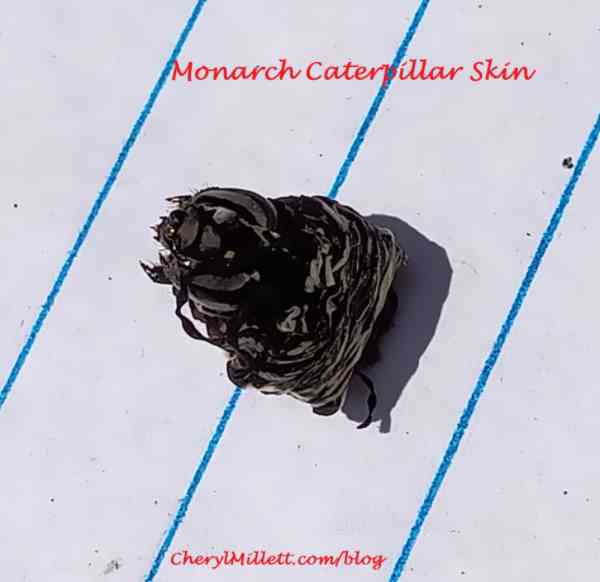
Shedding Its Caterpillar Skin
Out of the corner of my eye and on the floor of the caterpillar home, I spied a dark black piece. What could this be? The chrysalis had formed over night. For each first, I marveled at what took place. The black piece was the skin all crumpled up like an accordion. Light as a feather. I kept all the skins until the home needed to be stored away for another year, another project. The chrysalides skin was also saved until such time. I wanted to observe how both skins behaved…would they turn colour? Over time, the caterpillar skin was rubber like and the chrysalis skin hardened and wrinkling at the edges.
The Grand Timing and Accident
It does take many caterpillars to be able to catch a glimpse of the transition from caterpillar to chrysalis. Oh, you may be fortunate and see it the first time. Quite often, the chrysalis would be formed before my morning entrance into my health studio. That’s just the way it is.
With no expectations but still counting the hours, I felt there would be an opportunity this time with caterpillar number four. The lid with the hanging caterpillar was in position atop two tall candlesticks. I photographed and watched. With excitement, I prepared my Iridology camera (macro lens for photographing eyes balls) for a close-up photo shoot. What happened next hit me straight in the heart. I was beside myself when I heard a crash.
The lid was knocked by my Iridology camera and its unusually high wires for the flash. When I spied around the table, I saw the empty lid but all three chrysalides were intact but separated from the lid. I picked them up but found caterpillar #4 on one of the chair cushions. It hadn’t made it and was a bright green blob staining the cushion. After watching a few videos, I decided to reattach the three remaining chrysalides to the lid with dental floss. Worked like a charm. With a deep breath, I forgave myself for the accident. What else can you do? Little did I know, I would have many more caterpillars so the fallen one was always remembered among the total of 18 caterpillars. The fallen one! Pictures are still intact.
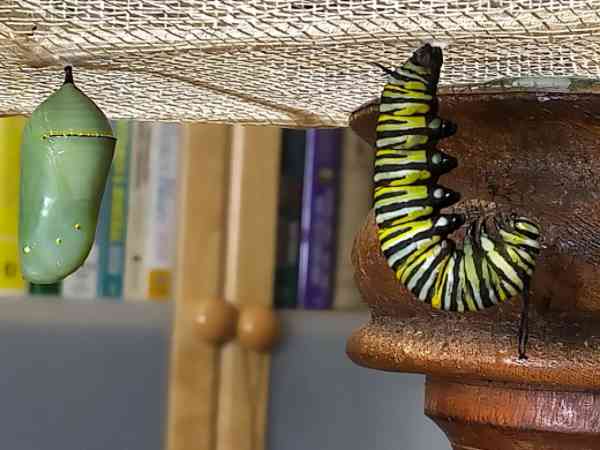
Pupating from Caterpillar to Chrysalis
First let me tell you, this project allowed me to learn how to spell chrysalis in the drop of a hat. Some words, we really don’t write very often. Chrysalis is one of them. According to some articles, the action is called pupating. With being very careful with the candlesticks and patient with my camera, I finally captured the transformation for the first time.
The Striking Beauty of the Chrysalis
We have all seen pupas or have we? They are usually tucked away and washed away with the elements. At times, I believe I have broom them from under tables and chairs along with other insect workings such as cobwebs. I had no idea just how beautiful the Monarch chrysalis is. The bright green of a newly birthed Monarch chrysalis takes your breath away but the chrysalis changes into a brilliant piece of art. The colour is vibrant green with colours of the sea. There are dots of gold in a few places. Black dots like remnants of the black in the caterpillar, dot across the very top and one third way down in a line. Next to them is some white and yellow. The caterpillar wants to remind you of its colours – black, yellow, and white.
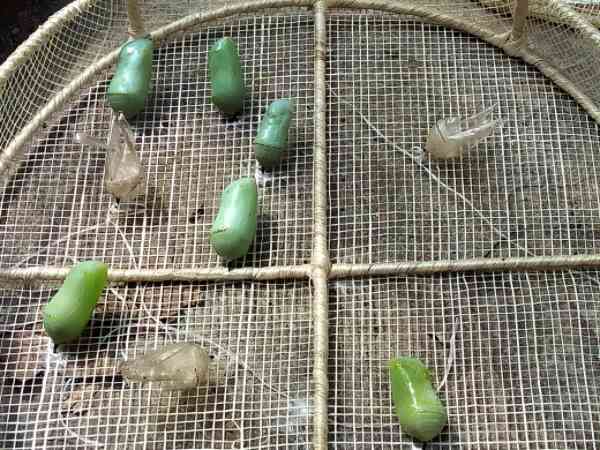


A Chrysalides Journey
With bated breath, it takes approximately 10-14 days for the butterfly to emerge. Excitement in every day! It was a waiting game as I took the opportunity to observe the first three chrysalides. Nellie told me very little but she did say that I would know when the butterfly was ready to emerge. After about ten days, the chrysalis would begin to darkened almost purplish. After a day or two, the colours orange and black would begin to seep through. As the butterfly grew within and pushed out on the skin, you could see the outline of the butterfly. By this time, the skin was clear and transparent. The time was very near to meet and greet the first butterflies.
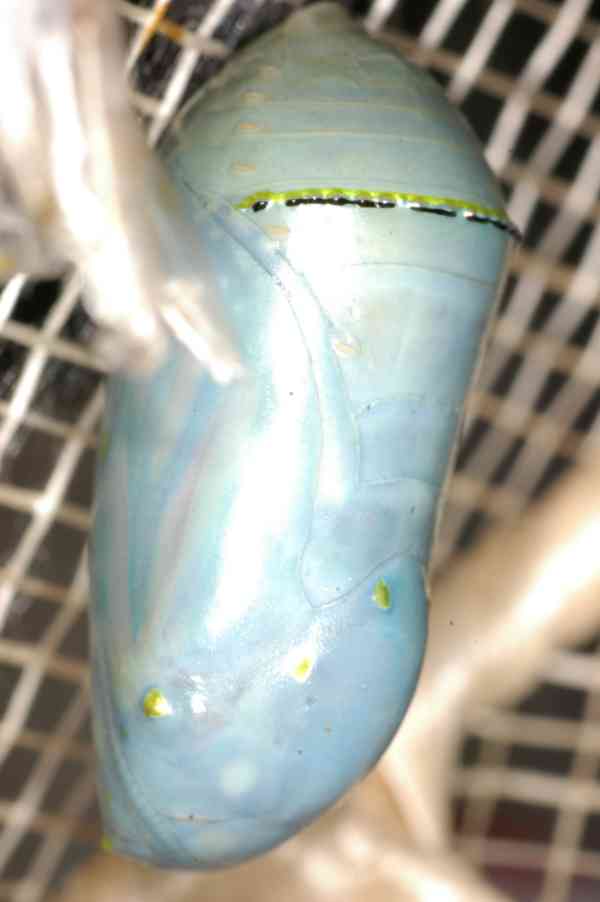
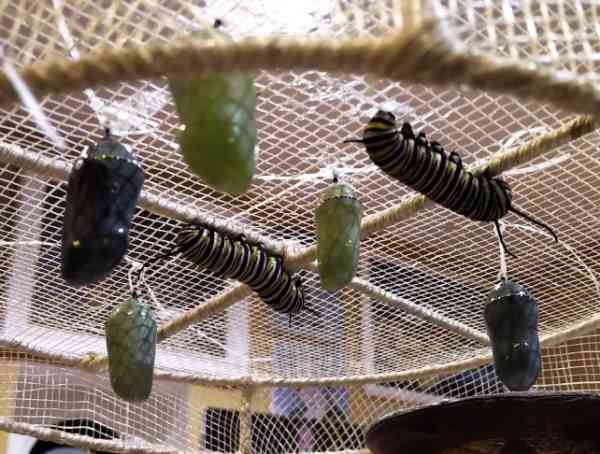
Welcome into the World
The moment has come to acknowledge the purpose of bringing the caterpillars to a safe home. With tears of joy, the first chrysalis opens and out comes a beautiful Monarch butterfly. The first goal seems to be intuitive for the butterfly. It is to climb to the top of the chrysalis’ skin and hang to dry. The moment happens very quickly. With patience and camera on tripod, one of the butterflies was captured on film (digital era now.) While others were photographed.
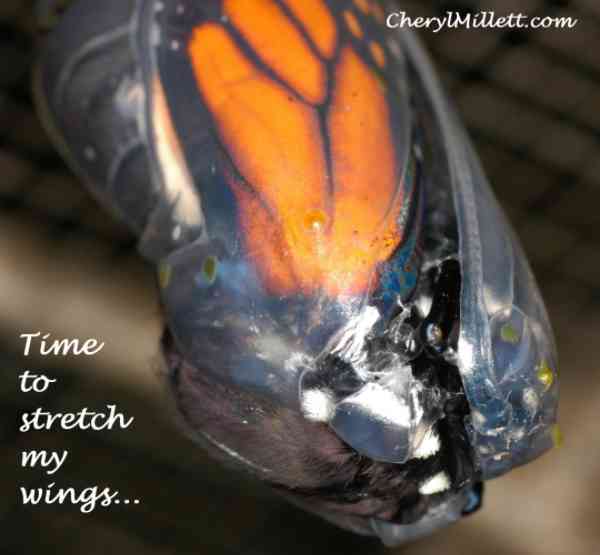
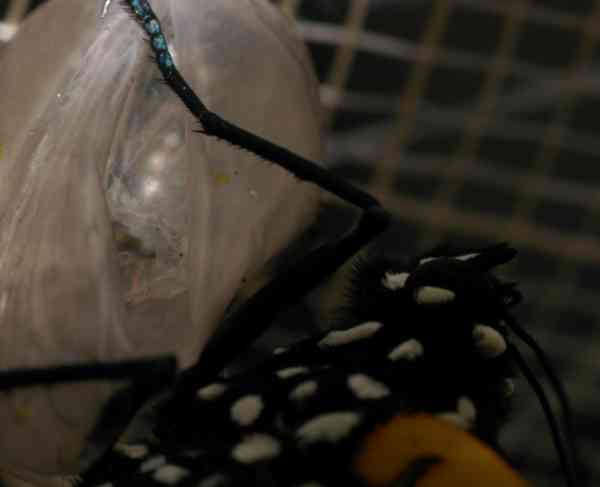

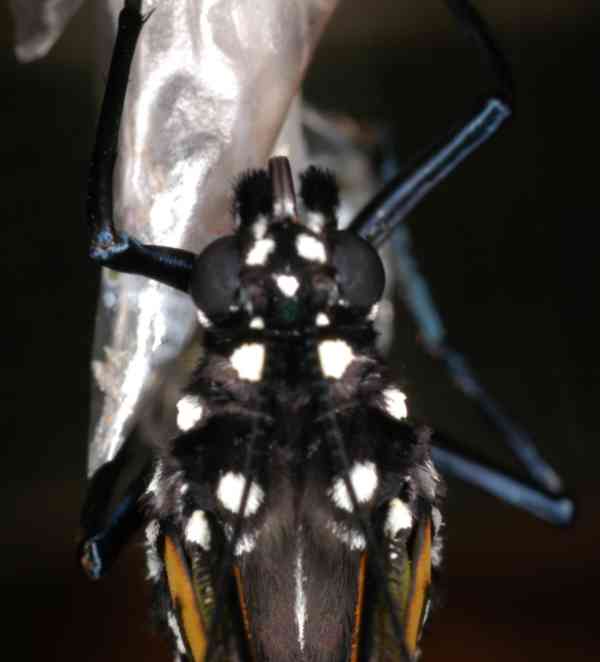
Hanging On
As the caterpillar dries, the wings unfurl to stretch down to its full length – the wings that will take it high about the towns, riding the winds to Mexico. My thing was to catch a first glimpse of the opened wings to determine if it was a male or female. A male has a blackish dot on each side along one of its black lines.
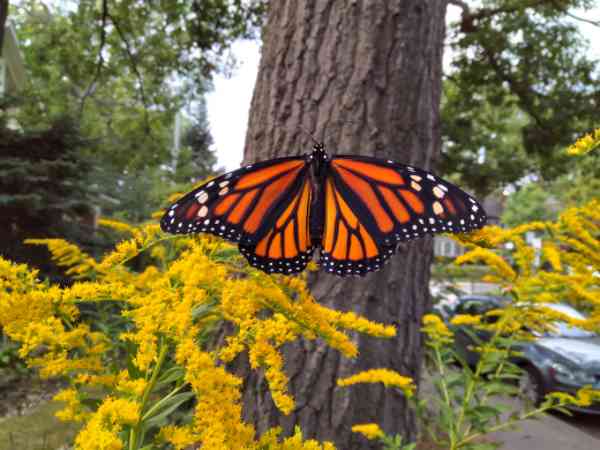
Female Monarch Butterfly
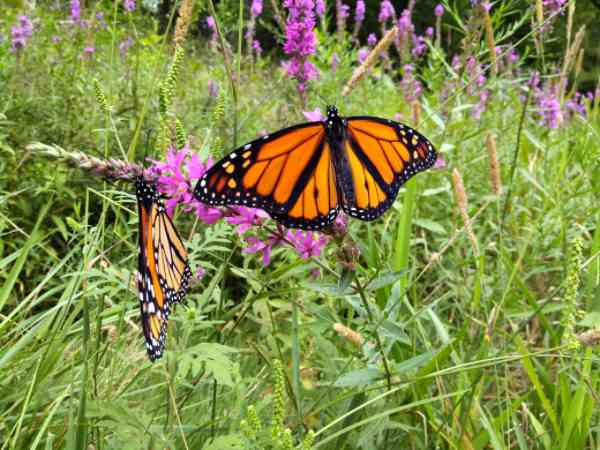
Male Monarch Butterfly
Drying Wings
Before it opens it wings, it hangs peacefully to dry its body and wings. The first drop is brownish in colour and may be the clearing out of its digestive tract. After that, the several drops are white and tasteless. Yes, curious me, I tasted the clear water that dripped onto my hand as I was carrying the still drying butterfly to the ravine to release it. I decided that carrying the entire home with the other chrysalides bouncing around wasn’t a good idea (first butterfly release.) The journey took me a good ten minutes of walking and you soon realize just how difficult it is to be still when walking. I then learned that the butterfly isn’t going to fly anytime soon. It takes about three to four hours to dry and be ready to take its first flight.


Butterflies resting before flying away. How can you not take advantage of the drying butterflies for some photos ops?
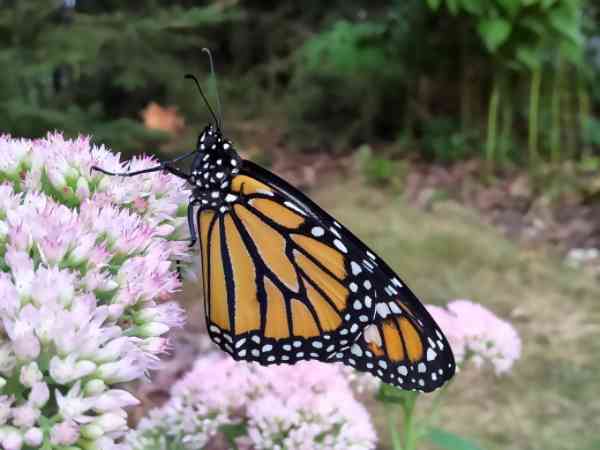

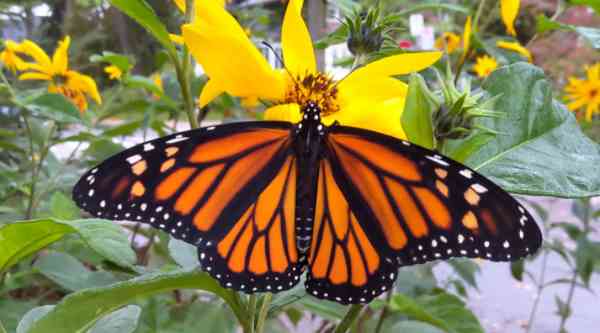
Butterfly Release on Sunflower
With work and all, I wasn’t always able to see the butterflies fly up and away. For those times, I would place the butterfly on a flower so they could fly on their own time.
An Experience of a Lifetime
My uncle was in town and had the opportunity to release one for one more experience of his lifetime.
Meet Chubby Checker who wiggled and wiggled until it plum fell down but still emerged as a beautiful butterfly.
Spontaneous Moves
Early one morning, a butterfly was just birthed but I had no idea how long it would take to dry so in my bare feet, shorts, and a tank top with no phone (so no camera) and no keys (empty handed as they say accept for the butterfly), I ventured to the nearby ravine, Nordheimer Ravine. I wanted to see the first flight of a butterfly. After arriving, I settled on a bench near the meadow and began observing the butterfly’s next moves. This butterfly was quite content. The water drops fell gently on my hand. At that time, the dogs and their owners would walk on by without a boo.
There was this one guy looking my way as he was walking his dog. He stopped and I share with him what I was doing. I was waiting to see my first flight of a butterfly. He told me about how he loves butterflies and tells stories to people about butterflies. I said he could join me and watch too and he was elated with the offer. These people are severely depressed and what beautiful stories he would share with them. Mr. D. did get to witness the butterfly taking off and then we walked together for a bit through the ravine.
Butterfly Release Makes Her Day
Timing is key. A good friend of mine named Susan, was coming over. With excitement, I ask her to put her things down on the bench because she was going to release a Monarch butterfly. It pleased me to be able to share The Monarch Project experience with others. Just like a little kid, I placed the butterfly on her hand and we walked to the front yard where the flowers were. By this time, I knew it would only be 30-60 minutes. Worth every moment. Neighbours passing by said hello. This butterfly was named Martta after Susan’s mother (Finnish name.) Butterflies like to climb high before they launch…some do. This one was one of those. With the two claws on each of Martta’s four legs, she climbed up her arm onto her head. What a joyous giggly time.
Photos of Susan holding Martta.


A few others had the opportunity to hold one before they flew…a four year old boy who so happened to be with his dad on my way walking to the ravine, a story teller and new friend, a neighbour, and my Uncle Robert.
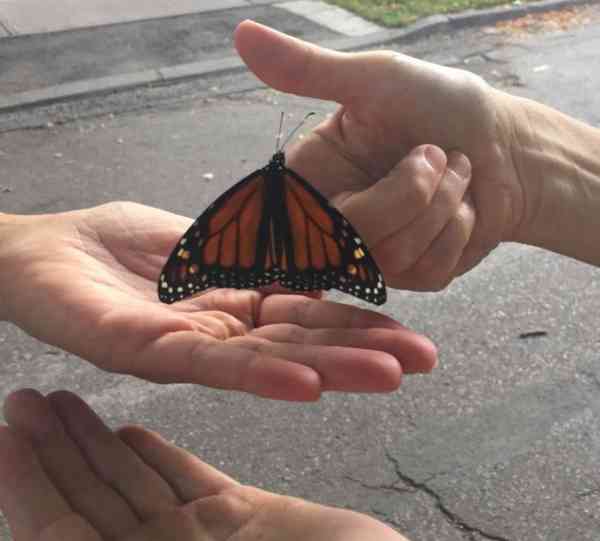
One lucky neighbour!
A couple of children were too shy to hold it. Perhaps next time!
The Last of the Monarch Caterpillars and Butterflies
Her name was Fall because it was Friday, September 24, 2021 when I spied a caterpillar on my walk to the garden. She was the biggest caterpillar and due to the cooler temperature, she remained a chrysalis a little longer than 14 days.
Click here for the complete story, photos, and video.
Thank you for joining me on this journey. I wish you motivation to keep an eye open for milkweed plants and Monarch caterpillars. You may even wish to plant some milkweed and plants that provide butterflies with flower nectar. In the least, you marveled at nature.
Warmly,
Cheryl


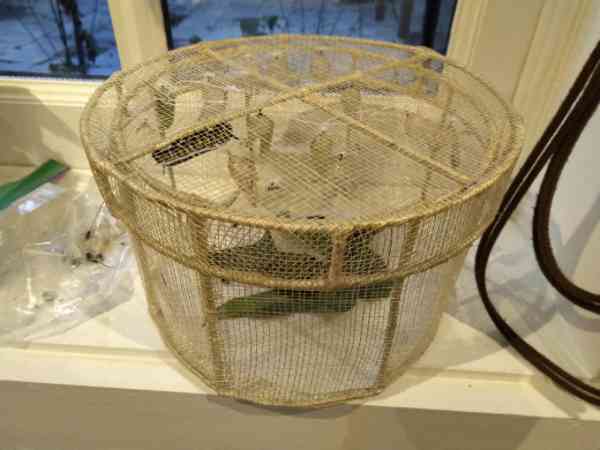



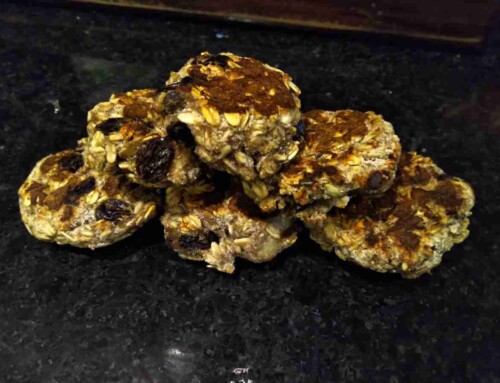

Beautifully done Cheryl………??CONGRATULATIONS ?????